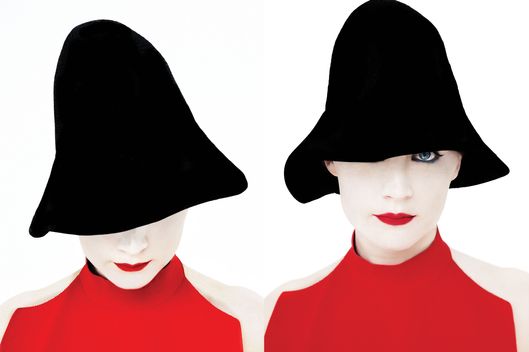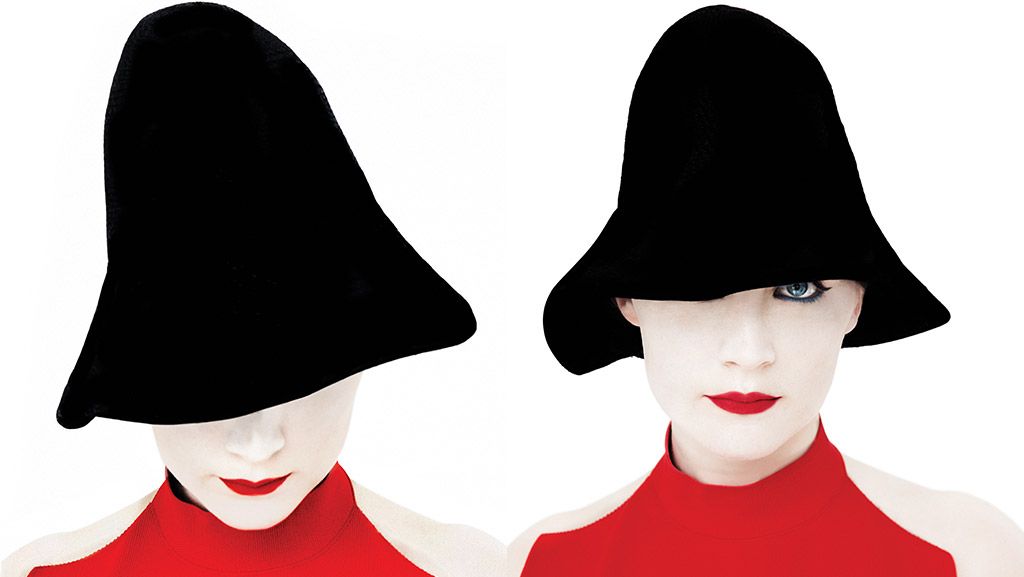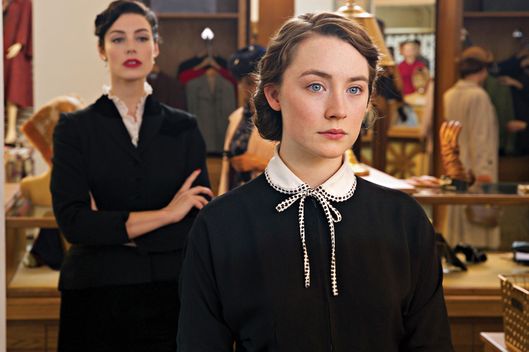Balenciaga
See it »
“What Saoirse captures more than anything else is the drama of her own growth.”


The woman next door to us had two sisters. One emigrated to England, the other to America. The English sister worked in an office in Liverpool; the American sister was a housekeeper for a family in Connecticut who were, my mother said, “fabulously wealthy.” Each summer, both sisters came home to Ireland for a few weeks. The English sister was quiet and remained in the shadows. The American sister, on the other hand, was all glitter and fascinating talk. She came with suitcases filled with clothes that had been cast off by her American employers. Women visited from all parts of our town to look at these clothes, to marvel over the bright colors and the fashionable cuts. Every afternoon, you could hear the noise of cooing coming from the house next door as the American sister produced another dress or costume or cardigan, or showed them the sort of shoes they had only seen in the movies.
Saoirse Ronan’s parents came to New York in the 1980s, two decades after our neighbor’s sister and three decades after the protagonist of my novel Brooklyn, whom she would come to play onscreen. Saoirse was born in New York and then taken home to Ireland when she was 3. Having parents who had lived in America singled you out in Ireland; even the idea of living there until you were 3 gave you a sort of glamour, a glamour that was often belied by the sort of work that Irish immigrants did in New York in the 1980s and by their living conditions.
The Ronans, on their return, came to live close to my town in Ireland. In fact, as Saoirse was growing up, they used to go to my local cinema. Thus she knows the inflections of my town, the tiny details of behavior and the mannerisms. But she knows something else, too, which sets her apart and gives her a sort of distance, a grandeur. She seems to have a real sense of her own almost ethereal beauty. You notice this when she comes into a room. She has a way of holding herself apart, controlling the light, controlling the response of those who turn to watch her.
And this can then dissolve into easy laughter or self-deprecating ease. It is as though she has aspects of both of the two sisters who emigrated from Ireland. She invites envy, she lives in light, she loves glamour, but she also moves easily into the shadows.
At the age of 12, when Saoirse played the lead part in the movie Atonement, she found a way of transcending Irish America and small-town Irish life, and later, in films like The Lovely Bones and The Grand Budapest Hotel, she managed to transform herself, as though as an actress she was emigrating again, this time to a place of her own choosing. But she had never played an Irish role on film until Brooklyn, she had never conjured with her own ambiguous legacy as someone familiar with rural Ireland who was also intensely glamorous and ready to be transformed.
Like all of us in Ireland, she learned the national need to be funny and to be ready to be amused and the demand to be self-deprecating when necessary, which is most of the time. In Ireland, people are skilled at playing the one who has known defeat. But watching Saoirse over the past while, I have noticed, especially when she is alone in her thoughts, or when she is aware of being watched, a deep knowledge of her own worth, a way of standing and moving that suggests a self-conscious poise and a refusal to accept defeat or to allow self-deprecation to undermine her own rare talent.
During the filming of the movie, to amuse me, they gave me the part of an extra, making me wear an old suit and a cap and placing me in front of Saoirse in a line of immigrants waiting to get into America. As we waited each time for the scene to be reshot, I observed how funny she was, how ready to be amused even by the smallest thing, how willing to appear ordinary, as though starring in the film were no big deal. But then, when it would come time to work, she would change completely. She would adjust her posture, look around carefully as though deliberately pulling the light in toward her wonderfully expressive face. She created a barrier around herself. There were no more jokes, and there was nothing self-deprecating about her. She had moved from Ireland to America in a few seconds, or moved from being a child star to a stunning actress.

In the film, the change that happens to Saoirse’s character is registered in how she dresses, the colors she wears. Her clothes in turn affect her posture, how she smiles, how she deals with the world. The story began for me by watching Irish people like our neighbor’s sister who came home from America, people who had a sort of high self-confidence that no one in Ireland had, people who seemed to relish being observed with admiration as they walked through the town. They had white teeth and good suntans. They thought life was short.
It was easy then to imagine the sort of young Irish emigrant who lives in the shadows gradually becoming a new person in the early 1950s because of American fashion. Eventually, Brooklyn slowly came to seem like a haven to the young Eilis Lacey, as it did to many others of her generation, as it did also in the early years of this century when parts of Brooklyn such as Williamsburg became havens for anyone who was young and talented and could not afford to live in Manhattan. In 2000, when I came to teach at the New School, I discovered that the students were not living in the East Village anymore (not to mention Greenwich Village). They were all making a virtue out of Brooklyn, citing dives and drinking holes there with awe and wonder in the same way as previous generations had spoken of the White Horse or the Kettle of Fish. Everyone in their right mind, they made clear to me, lived in Brooklyn.
Brooklyn, today, is a set of erasures. No matter what you do, even if you spend your time obsessing about the price of real estate, Brooklyn is filled with ghosts, perhaps more than any other place in America. So many countries — Norway, Ireland, Italy, for example — sent vast numbers of people to Brooklyn in the first half of the 20th century. You can still trace the Irish from the plaques and nameplates in the Catholic churches. Part of Eighth Avenue in Brooklyn’s Sunset Park, which is now populated by Chinese people, was known as Lapskaus Boulevard because of the number of Norwegians living there — lapskaus being a sort of Nordic beef stew. Bay Ridge was known as Little Oslo. There were nearly 60,000 Norwegians living there by 1940.
About a decade ago, I started occasionally going to Mass at St. Boniface in Downtown Brooklyn and then walking from there to Clinton Street in Cobble Hill, where a friend has a neighbor whose house was an Irish boardinghouse until the 1970s. This is a journey I began to imagine for my protagonist in the novel, and as I made the walk from my Catholic church to Cobble Hill, especially at night, it was not hard to imagine how lonely this might have been for so many Irish people, the streetscapes unlike anywhere in Ireland. And then it struck me how enabling it also might have become, how slyly happy you might be, knowing you were not about to meet your aunt, or your cousin, or anyone you knew. You could invent yourself here, even if the term self-invention was not yet understood by you.
In the scenes where she is homesick in the film, Saoirse used her own experience of leaving home, of going on her own for the first time to live in London. London is filled with excitement now that they have given up serving English food in their restaurants; it is even cool to be Irish there at the moment. (We are sexier and funnier and better looking and generally smarter than they are.) No London gathering is complete without us.
But London is an even more difficult city than Brooklyn to be alone in. The suburbs are all spread out and strange and distant. It is like living in a Yonkers with a good transport system and people talking with English accents.
Eilis’s newness, her rawness, her sadness are suggested in the film by her dark-green coat, by her lank hair, by a fearful way of moving. The first big change is when she appears on the steps of Brooklyn College wearing a necklace, her hair freshly done, with new light in her eyes and a new ease in her movements. And then, after considerable preparation, when she goes to Coney Island with Tony, her Italian boyfriend, she walks as though this world belongs to her.
But still, Saoirse does not display a fixed sense of herself as fantastically glamorous when her character returns to Ireland. Instead, she manages to capture the ambiguous performance we all try on when we come home from America. Sometimes she tries to fit in, to pretend that she has not changed at all and that being away is no big deal; other times she flaunts her new self. There is one moment when she walks through the small Irish town wearing sunglasses and a brightly colored dress when she seems like a returned Yank, like our neighbor’s sister, ready to gather the poor natives around her to show them the style she has acquired.
What Saoirse captures in the film more than anything else, however, is the drama of her own growth, by which she overcomes the conflict between her way of being Irish — never showing arrogance or pride, being happier always in the shadows — and an acute knowledge of her own power.
By the time she is back on the boat to Brooklyn, both the protagonist and the actress have transformed themselves. That final scene on the boat shows what a majestic change has taken place. While her posture is different and her clothes are amazing, there is something in her aura, reflected in the clarity of Saoirse’s gaze and the sort of shy distance in her smile, which suggests that her spirit has remained stable. In that sense of stability mixed with mystery, Saoirse Ronan manages to give the character the afterglow of someone who has become intensely real for herself and for others. She has come home to a place that is neither Brooklyn nor Ireland but rather a place that she herself has imagined and embodies.
Styling by Rebecca Ramsey; hair by Ted Gibson for Jed Root; makeup by Aya Komatsu at BRIDGE using CHANEL Beauté; nails by Elena Capo at the Wall Group.
*This article appears in the February 8, 2016 issue of New York Magazine.
A good guide for avid The Crown fans.
It’s About Time You Learned Tove Lo’s NameThe singer has crafted pop hits you’ve heard a thousand times by now.
Marina Abramovic Has Outlasted Her Lovers and, She Hopes, Her CriticsThe world's most famous performance artist at 70.
The Wing: Do Women Still Need a Space of Their Own?This exclusive social club for women, is part sorority, part start-up.
In Virtual Reality, Women Run the WorldA new generation of female artists is making VR the most diverse corner of the male-dominated tech space.
The Novelist Disguised As a HousewifeShirley Jackson wrote 17 books while raising four children — and she couldn't have had a successful career without them.
Ava DuVernay on Hollywood Racism, Modern-Day Slavery, and Why She’s Still an OptimistThe director, whose new documentary The 13th chronicles America’s history of racial subjugation, talks to Rebecca Traister about Bill Clinton, Newt Gingrich, and the modern criminal-justice system.
What No One Tells Couples Trying to ConceiveIt helps to be rich.
The Hidden Black Women Who Helped Win the Space RaceA segregated unit of mathematicians born of desperation during World War II became the secret to NASA’s success.
Slut-Shaming Squids Are EverywhereThe “Bermuda Square” comic strip is back.
The collaboration that dreams are made of.
Good Morning America Host Amy Robach Apologizes for Saying ‘Colored People’ on AirShe quickly apologized.
Unknown NFL Player Tries to Get Attention by Asking Aly Raisman Out in VideoThat’s one way to do it.
Don’t Mess This Up, Mischa BartonMarissa Cooper is poised for a comeback ... maybe.
California Votes to Remove Time Limit on Prosecuting Rape CasesIn light of the Bill Cosby case.
Beyoncé’s Behind-the-Scenes Lemonade Photos Belong in a MuseumShe had the "Boycott Beyoncé" sign already in formation on set.
The Rise of the Male Celebrity Full-FrontalAn ex-publicist explains.
Gabby Douglas Will Be a Miss America JudgeThe gold-medal gymnast will help choose the 2017 pageant winner.
Camille Becerra’s Photo Diary of Rockaway BeachAn ideal trip to add and cross off your summer bucket list.
Sorry Nerds, Ian McKellen Won’t Officiate Your Expensive Lord of the Rings–Themed WeddingNot even for $1.5 million.